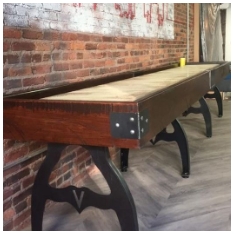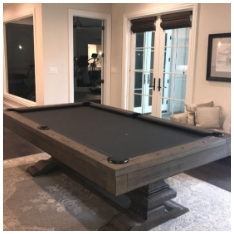If you're new to cue sports or considering adding a table to your home, understanding the differences between a snooker table and a pool table is essential. While they may appear similar at first glance, several key distinctions set these tables apart, affecting gameplay, strategy, and the overall experience. This guide will help you navigate these differences and make an informed decision.

Table Size and Dimensions
One of the most noticeable differences between a snooker table and a pool table is their size. Snooker tables are generally larger than pool tables, which has a significant impact on gameplay.
Snooker Table:
- Dimensions: A standard full-size snooker table measures 12 feet by 6 feet (3.66m by 1.83m). The playing surface is vast, requiring more precision in shots.
- Impact on Gameplay: The larger table size means longer shots and a more challenging game. Players need to master cue control and positioning.
Pool Table:
- Dimensions: Pool tables come in various sizes, but the most common are 7 feet, 8 feet, and 9 feet in length. The playing surface is more compact compared to a snooker table.
- Impact on Gameplay: The smaller size makes pool more accessible for beginners. Shots are shorter, and the game is generally faster-paced.
Pocket Size and Shape
Another key difference is the size and shape of the pockets. The design of the pockets influences the difficulty of the game.
Snooker Table:
- Pocket Size and Shape: Snooker table pockets are smaller and have rounded edges. This design requires more accuracy when potting balls.
- Impact on Gameplay: The smaller pockets increase the game's difficulty, demanding precise aiming and a gentle touch.
Pool Table:
- Pocket Size and Shape: Pool tables have larger pockets with more angular corners, making it easier to pocket balls.
- Impact on Gameplay: The larger pockets make the game more forgiving, allowing players to take more aggressive shots.
The Balls Used in Each Game
The balls used in snooker and pool are different in size, weight, and color, affecting the strategy and flow of each game.
Snooker Balls:
- Size and Color: Snooker balls are smaller, with a diameter of 52.5mm. The game uses 21 balls in total: 15 red balls, six colored balls (yellow, green, brown, blue, pink, black), and a white cue ball.
- Gameplay Impact: The smaller balls and the larger table surface mean that players need to be more precise in their shots and positioning.
Pool Balls:
- Size and Color: Pool Balls are larger, typically measuring 57mm in diameter. The standard set includes 15 numbered balls (1-8 solids, 9-15 stripes) and a white cue ball.
- Gameplay Impact: The larger balls and smaller table make for a faster game, with less emphasis on precision and more on shot-making skills.
Gameplay and Rules
The rules and gameplay mechanics between snooker and pool also differ significantly, shaping the overall experience.
Snooker Gameplay:
- Objective: The goal in snooker is to score more points than your opponent by potting balls in a specific sequence. Players alternate between potting red balls (each worth 1 point) and colored balls (worth between 2 and 7 points).
- Game Duration: Snooker games can be lengthy, often requiring deep concentration and strategic thinking. Matches can last several hours.
- Skill Level: Snooker is considered more challenging due to the table size, pocket design, and shot complexity.
Pool Gameplay:
- Objective: The most common pool games are 8-ball and 9-ball. In 8-ball, players aim to pocket all their designated balls (solids or stripes) before sinking the 8-ball. In 9-ball, players must pocket balls in numerical order, with the goal of sinking the 9-ball to win.
- Game Duration: Pool games are generally shorter and faster-paced, making it a popular choice for casual play.
- Skill Level: While pool requires skill, it is often more accessible to beginners due to the forgiving nature of the table and pockets.
Table Surface and Cushions
The playing surface and cushions on the sides of the table also differ between snooker and pool tables, influencing the speed and accuracy of the game.
Snooker Table Surface:
- Material: Snooker tables typically have a slate bed covered with high-quality baize, a type of woolen cloth that provides a smooth surface.
- Cushions: The cushions on a snooker table are designed to provide a consistent and accurate rebound, which is crucial given the table's size.
- Gameplay Impact: The smooth surface and precise cushions contribute to the controlled and deliberate nature of snooker.
Pool Table Surface:
- Material: Pool tables also use a slate bed, but the cloth is often faster, made from a blend of wool and nylon. This results in quicker ball movement.
- Cushions: Pool table cushions are designed to provide a faster rebound, complementing the quicker pace of the game.
- Gameplay Impact: The faster surface and cushions allow for more dynamic play, with shots requiring less power and finesse compared to snooker.
Popularity and Cultural Significance
While both snooker and pool are popular cue sports, their cultural significance and popularity vary by region.
Snooker Popularity:
- Regions: Snooker is particularly popular in the United Kingdom, Ireland, and parts of Asia. It is often associated with a more formal and strategic style of play.
- Professional Scene: Snooker has a well-established professional circuit, with major tournaments such as the World Snooker Championship drawing large audiences.
Pool Popularity:
- Regions: Pool is widely played in North America and Europe. It is often seen as a more casual and accessible game, popular in bars and recreational venues.
- Professional Scene: Pool also has a professional circuit, with events like the World Pool Championship, but it is generally less formal than snooker.
Choosing the Right Table for You
When deciding between a snooker table and a pool table, consider your preferences, space availability, and the type of gameplay you enjoy.
- Skill Level: If you enjoy a more challenging and strategic game, a snooker table might be the right choice. However, if you prefer a faster-paced and more social game, a pool table could be better suited to your needs.
- Space: Snooker tables require more space due to their size. Make sure you have enough room to accommodate the table and allow for comfortable play.
- Budget: Pool tables are generally less expensive and come in various sizes, making them more accessible for home use. Snooker tables, due to their size and craftsmanship, tend to be pricier.
Final Thoughts
Understanding the differences between a snooker table and a pool table is key to making the right choice for your home or recreational space. Whether you prefer the precision and challenge of snooker or the fast-paced excitement of pool, both games offer unique experiences that can bring hours of enjoyment. Consider your space, budget, and skill level to determine which table best suits your needs.





